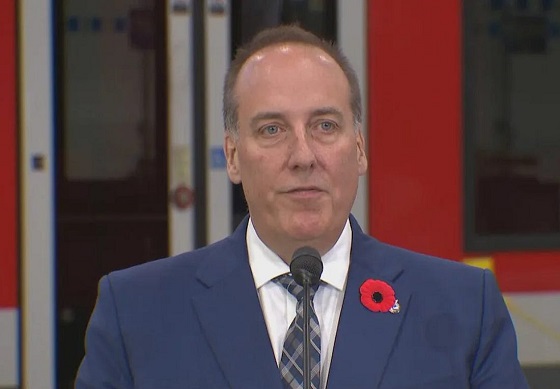Business
Business investment key to addressing Canada’s productivity crisis

From the Fraser Institute
By Tegan Hill
The Bank of Canada’s senior deputy governor Carolyn Rogers recently raised the alarm on Canada’s productivity crisis, saying “it’s an emergency—it’s time to break the glass.” But to address Canada’s productivity problem, which is contributing to our stagnant living standards, we must first address Canada’s weak business investment.
For perspective, Canada’s economic growth in the fourth quarter of 2023, as measured by per-person GDP, a common indicator of living standards, was $58,111, which is slightly less than it was at the end of 2014 at $58,162 (after adjusting for inflation). That means that over roughly the last decade, Canadian living standards have not increased. Indeed, our economic problems span well beyond the pandemic. In the five years prior to 2019 (the last pre-COVID year), Canada’s per-person GDP (inflation-adjusted) was the 4th weakest out of 38 advanced countries.
Unfortunately, prospects for the future are dim. According to the OECD, Canada will record the lowest rate of per-person GDP growth among 32 advanced economies over roughly the next 40 years. Countries such as Estonia, South Korea and New Zealand are expected to pass Canada and achieve higher living standards by 2060.
Given that growth in productivity—essentially, the value of economic output per hour of work—is key to higher living standards, it’s no surprise that Rogers and other analysts are raising alarms. But what’s at the heart of our productivity crisis?
Put simply, weak business investment. While the federal and many provincial governments have prioritized immigration and bigger government in an effort to stimulate productivity growth and grow our economy, they’ve ignored business investment, which has significantly declined in recent years.
From 2014 to 2022, inflation-adjusted total business investment (in plants, machinery, equipment and new technologies but excluding residential construction) in Canada declined by C$34 billion. During the same time period, after adjusting for inflation, business investment per worker declined (on average) by 2.3 per cent annually. In contrast, business investment per worker grew (on average) by 2.8 per cent annually from 2000 to 2014.
While business investment has generally declined in Canada since 2014, in other countries, including the United States, it’s continued to grow. As a result, Canada’s GDP per hour worked—a key measure of productivity growth—is among the lowest in the OECD.
Think of it this way; when businesses invest in physical and intellectual capital they equip workers with the tools and technology (e.g. machinery, computer programs, artificial intelligence) to produce more and provide higher quality goods and services, which fuels innovation and higher productivity. Because Canada has lower levels of investment in tools and technology, our workers are less productive.
But here’s the good news. Governments across Canada can enact policies to help stimulate business investment, productivity gains, and ultimately, stronger economic growth. The key is to reduce onerous regulations, rein in high government spending, and create a pro-growth tax environment that makes Canada a more attractive place for business to locate and invest. These policies have a proven track record of improving business investment in Canada. For its part, the Trudeau government can prioritize pro-growth policies when it tables the federal budget next week.
Clearly, without a change in the investment climate and stronger productivity growth, the economic outlook looks grim. Fortunately, Canadian governments can respond to this emergency with pro-growth policy reform.
Author:
Business
Liberal’s green spending putting Canada on a road to ruin

Once upon a time, Canadians were known for our prudence and good sense to such an extent that even our Liberal Party wore the mantle of fiscal responsibility.
Whatever else you might want to say about the party in the era of Jean Chrétien and Paul Martin, it recognized the country’s dire financial situation — back when The Wall Street Journal was referring to Canada as “an honorary member of the Third World” — as a national crisis.
And we (remember, I proudly served as Member of Parliament in that party for 18 years) made many hard decisions with an eye towards cutting spending, paying down the debt, and getting the country back on its feet.
Thankfully we succeeded.
Unfortunately, since then the party has been hijacked by a group of reckless leftwing fanatics — Justin Trudeau and his lackeys — who have spent the past several years feeding what we built into the woodchipper.
Mark Carney’s finally released budget is the perfect illustration of that.
The budget is a 400 page monument to deficit delusion that raises spending to $644.4 billion over five years — including $141.4 billion in new spending — while revenues limp to $583.3 billion, yielding a record (non-pandemic) $78.3 billion shortfall, an increase of 116% from last year.
This isn’t policy; it’s plunder. Interest payments alone devour $55.6 billion this year, projected to hit $76.1 billion by 2029-30 — more than the entire defence budget and rising faster than healthcare transfers.
We can’t discount the possibility that this will lead to a downgrade of our credit rating, which will significantly increase the cost of borrowing and of doing business more generally.
Numbers this big start to feel very abstract. But think of it this way: that is your money they’re spending. Ottawa’s wealth is made up entirely of our tax dollars. We’ve entrusted that money to them with the understanding that they will use it responsibly. In the decade these Liberals have been in power, they have betrayed that trust.
They’ve pursued policies which have made life in Canada increasingly unaffordable. For example, at the time of writing it takes 141 Canadian pennies (up from 139 a few days ago) to buy one U.S. dollar, in which all of our commodities are priced. Well, that’s .25 cents per litre of gasoline. Imagine what that’s going to do to the price of heating, of groceries, of the various other commodities which we consume.
And this budget demonstrates that the Carney era will be more of the same.
Of course, the Elbows Up crowd are saying the opposite — that this shows how fiscally responsible Mark Carney is, unlike his predecessor. (Never mind that they also publicly supported everything that Trudeau did when he was in government.) They claim that Carney shows that he’s more open to oil and gas than Trudeau was.
Don’t believe it.
The oil and gas sector does get a half-hearted nod in the budget with, for instance, a conditional pathway to repeal the emissions cap. But those conditions are important. Repeal is tied to the effectiveness of Carney’s beloved industrial carbon tax. If that newly super-charged carbon tax, which continues to make our lives more expensive, leads to government-set emissions reductions benchmarks being met, then Ottawa might — might — scrap the emissions.
Meanwhile, the budget doubles down on the Trudeau government’s methane emissions regulations. It merely loosens the provisions of the outrageous Bill C-59, an act which should have been scrapped in its entirety. And it leaves in place the Trudeaupian “green” super structure, which has resource sector investment, and any business that can manage it, fleeing to the U.S.
In these perilous times, with Canada teetering on the brink of recession, a responsible government would be cutting spending and getting out of the way of our most productive sectors, especially oil and gas — the backbone of our economy.
It would be repealing the BC tanker ban and Bill C-69, the “no more pipelines act,” so that our natural resources could better generate revenue on the international market and bring down energy rates at home.
It would quit wasting millions on Electric Vehicle charging stations; mandating that all Canadians buy EVs, even with their elevated cost; and pressuring automakers to manufacture Electric Vehicles, regardless of demand, and even as they keep closing up shop and heading south.
But in this budget the Liberals are going the opposite direction. Spend more. Tax more. Leave the basic Net-Zero framework in place. Rearrange the deck chairs on the Titanic.
They’re gambling tomorrow’s prosperity on yesterday’s green dogma, And every grocery run, every gas fill-up, every mortgage payment will serve as a daily reminder that we are the ones footing the bill.
Once upon a time, the Liberals knew better. We made the hard decisions and got the country back on its feet. Nowadays, not so much.
Business
Carney doubles down on NET ZERO

If you only listened to the mainstream media, you would think Justin Trudeau’s carbon tax is long gone. But the Liberal government’s latest budget actually doubled down on the industrial carbon tax.
While the consumer carbon tax may be paused, the industrial carbon tax punishes industry for “emitting” pollution. It’s only a matter of time before companies either pass the cost of the carbon tax to consumers or move to a country without a carbon tax.
Dan McTeague explains how Prime Minister Carney is doubling down on net zero scams.
-

 Artificial Intelligence1 day ago
Artificial Intelligence1 day agoAI Faces Energy Problem With Only One Solution, Oil and Gas
-

 National1 day ago
National1 day agoWatchdog Demands Answers as MP Chris d’Entremont Crosses Floor
-

 Health1 day ago
Health1 day agoLack of adequate health care pushing Canadians toward assisted suicide
-

 Media1 day ago
Media1 day agoBreaking News: the public actually expects journalists to determine the truth of statements they report
-

 Business21 hours ago
Business21 hours agoLiberal’s green spending putting Canada on a road to ruin
-

 Artificial Intelligence1 day ago
Artificial Intelligence1 day agoAI seems fairly impressed by Pierre Poilievre’s ability to communicate
-

 Alberta1 day ago
Alberta1 day agoATA Collect $72 Million in Dues But Couldn’t Pay Striking Teachers a Dime
-

 Business22 hours ago
Business22 hours agoCarney doubles down on NET ZERO







